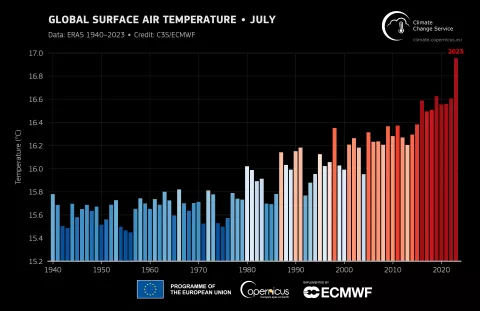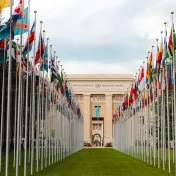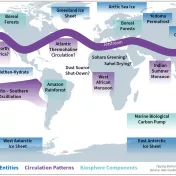Scorching heat, heavy rainfalls, raging wildfires, deadly floods, and devastating storms – the manifestations of extreme weather events have become a common phenomenon around the globe. As the world grapples with the ever-increasing impacts of climate change, the year 2023 has emerged as a stark reminder of the planet's and humankind's vulnerability to extreme weather events. From devastating wildfires to powerful hurricanes and record-breaking heatwaves, the past twelve months have witnessed a series of unprecedented natural catastrophes.
Real world situation on climate impacts
1. Scorching heatwaves
Throughout 2023, many regions experienced intense and prolonged heatwaves, breaking temperature records and putting a strain on communities and ecosystems. In the United States, China, Southern Europe, North Africa, and the Middle East temperatures set records, with deadly consequences for some of those unable to escape the heat. In July, temperatures exceeded 50°C in Death Valley in the US as well as in Northwest China. In parts of Spain, France, Italy, Greece, and Bosnia temperatures topped 40°C, while Sicily saw temperatures as high as 46.3°C. Globally, June through August marked the world’s hottest three-month period in recorded history, and the average global temperature in July was more than 1.1°C hotter than last century’s average, according to the United States’ National Oceanic and Atmospheric Administration (NOAA). The first week of July 2023 was the Earth’s hottest on record. The scorching temperatures not only posed a direct threat to human health and wildlife but also led to severe droughts, water shortages, and stressed agricultural systems.

ECMWF, Copernicus Climate Change Service (C3S)
In July 2023, the globally averaged surface air temperature broke historic records.
2. Raging wildfires
Raging wildfires swept through several continents in 2023, leaving destruction in their wake. Unprecedented fire seasons were observed, with flames engulfing vast swaths of forests, threatening wildlife habitats, and displacing communities. Canada experienced the most destructive wildfire season ever recorded with a staggering 16.5 million hectares of land being torched by fire – an area larger than Greece and more than double the previous record from 1989. In Europe, Greece suffered its most intense burst of wildfires ever and the largest ever recorded in the EU. In the Pacific, a blaze on the Hawaiian island of Maui became the deadliest US wildfire in more than a century.
3. Supercharged hurricanes and cyclones
Coastal regions faced the fury of supercharged hurricanes and cyclones in 2023. Warmer ocean temperatures provided the energy needed for these storms to intensify rapidly, leading to stronger winds, heavier rainfall, and more destructive storm surges. The deadliest-ever Mediterranean cyclone Daniel dropped record rainfall in Libya, overwhelming dams and causing catastrophic flooding; more than four thousand people have died with over 10,000 people missing. Storm Daniel, also affecting Greece, Turkey, and Bulgaria, became the costliest tropical cyclone outside of the north Atlantic Ocean with over USD 20 billion in estimated damages. In May, tropical cyclone Mocha is reported to have killed at least 145 people in Myanmar and affected roughly 800,000 people in the region.
4. Flash floods and extreme precipitation
Flash floods wreaked havoc in various parts of the world as intense rainfall events overwhelmed drainage systems and riverbanks. Urban areas, in particular, faced the brunt of these extreme precipitation events, resulting in widespread flooding, property damage, and loss of life. Heavy monsoon rain caused flash floods and landslides in northern India that killed more than 100 people. The Chinese capital Beijing experienced its heaviest rainfall in at least 140 years, resulting in major flooding that affected nearly 1.29 million people, damaged 147,000 homes, and caused at least 33 deaths. And in the US, heavy rainfall caused Vermont’s worst floods in a century, while parts of Kentucky recorded their highest-ever totals for twenty-four-hour rainfall, according to NOAA. Overall, the summer’s flooding caused billions of dollars in damages.
Climate change is increasing its handprint
Over the past decades, scientists have delved deeper into the causes of extreme weather. In recent studies, a stark reality emerges – the unmistakable link between climate change and the surge in the intensity and frequency of extreme weather events. And there is no doubt among the scientific community that climate change was the driving force behind the numerous deadly climate events this year. Some scientist refer to humanity entering “uncharted territory” as global warming is expected to increase to 2.6°C over the course of the century, with a potential risk of collapse of natural and socioeconomic systems in a world where humanity faces unbearable heat, frequent extreme weather events, food and fresh water shortages, rising seas, more emerging diseases, and increased social unrest and geopolitical conflict.
As temperatures continue to soar and heatwaves become more frequent and intense, the scientific consensus on the link between these extreme events and climate change is unequivocal. Numerous studies conducted in recent years provide compelling evidence that the warming of our planet is a driving force behind the surge in heatwaves. Scientists from the World Weather Attribution initiative collaborated to assess to what extent human-induced climate change altered the likelihood and intensity of the extreme heat in July 2023. They concluded that in all the regions a heatwave of the same likelihood as the one observed would have been significantly cooler in a world without climate change. Similar to previous studies they found that the heatwaves observed are 2.5°C warmer in Southern Europe, 2°C warmer in North America and about 1°C in China in today’s climate than they would have been if it was not for human-induced climate change. In addition, a study by non-profit Climate Central found that climate change made southern US heatwaves five times more likely to happen.
Deadly amounts of rainfalls are also a direct consequence of climate change. A report published in September 2023 found that climate change had made Libya’s flood disaster 50 times more likely and Greece’s fires up to 10 times more likely and 40% more intense. Once again, the World Weather Attribution group evaluated the role of climate change in extreme weather events, and found that the impact of the floods were made worse by factors such as deforestation and urbanisation in the countries, which led to a change in landscape and exposed more people to flooding.
COP28: A global response?
The extreme weather events of 2023 serve as a stark reminder that climate change is not a distant threat but a current and pressing reality. As we witness the increasing frequency and intensity of these events, it is imperative that nations, communities, and individuals take concerted action to mitigate the root causes of climate change, adapt to its impacts, and work towards a more sustainable and resilient future.
This year, the annual UN climate change conference hosted by the United Arab Emirates in Dubai provided the opportunity for world leaders to discuss and agree on a global response, since the urgency of the situation demands collaboration on a global scale to address the challenges posed by extreme weather events. A key development here was the operationalisation of the Loss and Damage Fund (LDF), scaling up support for countries and people particularly threatened by the climate crisis. However, pledges totaling USD 700 million fall significantly short of the USD 580 billion needed by 2030. Recent announcements only cover 0.2% of Loss and Damage (L&D) finance needs and are not responding to the principle of common but differentiated responsibilities and capacities. Additionally, the Santiago Network for Loss and Damage, tasked with providing technical assistance in the context of L&D, was fully operationalised but also faces funding challenges.
Not only L&D, but also adaptation is important in tackling climate change impacts. Here the climate change conference also marked the adoption of the Global Goal on Adaptation (GGA) framework, addressing key concerns of climate-vulnerable nations. Despite this progress, the framework's goals lack specific, measurable targets, particularly in crucial areas like food security and health. A new two-year work program aims to develop these indicators. The funding gap for implementing adaptation measures, especially in developing countries, remains a critical issue needing urgent attention.
To effectively tackle the losses and damages induced by climate change, it's crucial to translate those recent developments into tangible actions. This is especially vital for those most vulnerable to the impacts of climate change. We must proactively address the losses and damages resulting from both extreme weather events and gradual climate changes. However, this approach alone is insufficient. There's an urgent need to significantly amplify our efforts in mitigating climate change and adapting to it. By doing so, we can not only confront current challenges but also proactively avert and minimise future losses and damages attributable to climate change. Based on the principles of common but differentiated responsibilities, historical responsibility and polluter pays, the countries of the Global North must therefore scale up their climate finance and mitigation efforts significantly and support countries of the Global South in their adaptation and mitigation efforts and the addressing of losses and damages.









